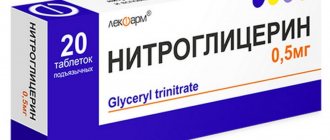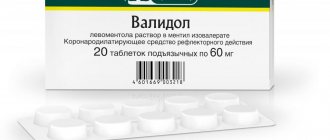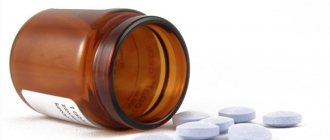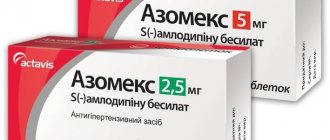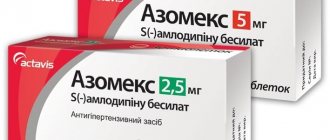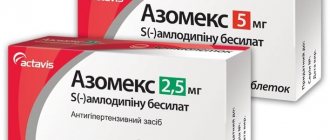Concentrate for solution for infusion Nitroglycerin is used for the following indications:
- Severe and prolonged pain of ischemic origin in the heart area, associated with myocardial infarction or unstable angina.
- Failure of the pumping function of the heart and pulmonary edema associated with acute myocardial infarction.
- Hypertension associated with open heart surgery and other surgical procedures.
- Ensuring controlled arterial hypotension during surgical interventions.
Contraindications
Hypersensitivity to nitroglycerin and other nitro compounds. Hypovolemia, severe arterial hypotension (systolic pressure <90 mmHg), acute myocardial infarction localized in the right ventricle, increased intracranial pressure (due to head injury or cerebral hemorrhage), cardiac tamponade, hypertrophic obstructive cardiomyopathy, constrictive pericarditis, angle-closure glaucoma, toxic pulmonary edema, anemia, acute vascular insufficiency (shock, vascular collapse).
Sildenafil. Concomitant use of the phosphodiesterase type 5 inhibitor sildenafil, since sildenafil potentiates the hypotensive effect of nitrates (the interval between doses should be at least 48 hours).
Nitroglycerin
In acute myocardial infarction or acute heart failure, it should be used only with careful clinical monitoring of the patient.
To prevent an increase in angina attacks, abrupt withdrawal should be avoided.
If the patient is known to be taking phosphodiesterase-5 inhibitors, drug therapy is contraindicated. Patients receiving therapy with the drug should be warned not to take phosphodiesterase-5 inhibitors (for example, sildenafil, tadalafil, vardenafil).
Against the background of intravenous administration of the drug, a significant decrease in blood pressure and the appearance of dizziness may occur during a sharp transition from the “lying” or “sitting” position to the “standing” position; hot weather, as well as increased angina (with a sharp decrease in blood pressure) and myocardial ischemia up to myocardial infarction and sudden death (paradoxical nitrate reactions). To prevent an undesirable decrease in blood pressure, the rate of drug administration should be individually and methodically selected correctly. A decrease in blood pressure can be observed not only during the period of selecting the rate of drug administration, but also later against the background of stabilized blood pressure. Therefore, blood pressure monitoring should be carried out at least 3-4 times per hour throughout the entire infusion time.
It is possible to develop tolerance and cross-tolerance to other drugs of the nitrate group with long-term use, especially in high doses. Patients previously treated with organic nitrates (eg, isosorbide dinitrate, isosorbide-5-mononitrate) may require a higher dose.
If blurred vision persists or is severe, treatment should be discontinued.
In patients with severe liver failure and severe renal failure, dose adjustment is required depending on the severity of the disease (especially when using high doses), it is recommended to start with the lowest possible dose. Careful monitoring of the patient is necessary.
Hypoxemia
Caution should be exercised when used in patients with arterial hypoxemia due to severe anemia (including glucose-6-phosphate dehydrogenase (G6PD)-induced deficiency) because the metabolism of nitroglycerin is reduced in such patients.
Caution is also required when used in patients with hypoxemia and impaired ventilation/perfusion due to pulmonary disease or heart failure; as well as in patients with angina pectoris, myocardial infarction or cerebral ischemia, with airway disorders (especially alveolar hypoxia).
Under these conditions, vasoconstriction occurs in the lungs in order to shift the perfusion of the area of alveolar hypoxia to the part of the lung with better ventilation (Euler-Lillestrand reflex). As a potent vasodilator, nitroglycerin may interfere with this protective vasoconstriction and consequently lead to increased perfusion of poorly ventilated areas, worsening venous-perfusion imbalances, and a further decrease in arterial partial pressure of oxygen.
Methemoglobinemia
The development of methemoglobinemia has been reported after use of the drug. Treatment of methemoglobinemia with methylene blue is contraindicated in patients with glucose 6-phosphate dehydrogenase or methemoglobin reductase deficiency.
Overdose
Symptoms: arterial hypotension, tachycardia, feeling of heat, hyperemia, headache, rapid heartbeat, fainting. Increased intracranial pressure, which can lead to confusion and neurological disorders. An overdose over several hours can lead to ethanol intoxication.
Treatment. Excessive hypotension can be corrected by reducing the rate of drug infusion or stopping its administration. In case of severe arterial hypotension, the patient should be placed in a horizontal position with the head of the bed lowered. For arterial hypotension associated with bradycardia, the use of atropine and dopamine is indicated. Hypoxia caused by methemoglobinemia can cause cyanosis, metabolic acidosis, coma, convulsions, and vascular collapse. For methemoglobinemia, a solution of methylene blue (1-2 mg/kg body weight) is administered.
A pronounced and rapid anti-ischemic effect, an equally pronounced and rapid effect on hemodynamics, “controllability” and safety - all these characteristics of nitroglycerin (NTG) have long ensured its role as one of the main drugs used to treat exacerbations of coronary heart disease (CHD; table. 1). The purpose of this report is to analyze current recommendations for the use of intravenous NTG in the treatment of patients with acute coronary syndromes (ACS).
Mechanism of action: antianginal, hemodynamic and other effects of NTG
The mechanism of action of NTG and other nitrates is closely related to one of the main vasoactive substances in the body - nitric oxide. Essentially, all nitrates should be considered as exogenous sources. Nitric oxide, by activating the enzyme guanylate cyclase, helps to increase the content of cyclic guanidine monophosphate (cGMP) in cells, a universal intracellular messenger that causes relaxation of smooth muscle structures.
The antianginal effect of NTG is based on multiple physiological reactions associated with both its direct effect on coronary blood flow and changes in a number of hemodynamic characteristics. By causing dilatation of both normal and atherosclerotic arteries, increasing blood flow in collaterals, NTG improves coronary circulation and promotes blood redistribution in favor of the ischemic zone. IGT causes both predominantly venous and arterial dilatation. By dilating the peripheral veins, NTG reduces the level of preload, which, in turn, reduces the tension of the left ventricle and its oxygen demand. By dilating peripheral arteries, NTG reduces afterload.
The indicated vascular effects of NTG (especially when administered intravenously) should be complemented by a beneficial effect on the parameters of the coagulation system, aggregation of blood platelets, and rheological properties of blood.
NTG in the treatment of ACS from the perspective of evidence-based medicine
Meta-analysis by S. Yusuf et al. [10] 10 small randomized studies performed in the period preceding the widespread use of thrombolytic therapy in the treatment of acute myocardial infarction (MI), and including a total of about 2000 patients, showed a fairly pronounced (35%) reduction in mortality in patients who received early intravenous administration NTG. The most serious (and large) controlled studies of nitrates in acute MI were performed in the early 90s. last century – GISSI-3 [2] and ISIS-4 [3]. They already provided for the use of thrombolytic agents. In fact, both studies, covering about 80 thousand patients, compared the effectiveness of 2 strategies - routine (“all in the absence of contraindications”) and selective (“according to indications”) use of nitrates in the treatment of acute MI. In this regard, the “traditional interpretation” of their result, as evidence that nitrates have no effect on the survival of patients with MI, does not seem entirely correct. It is probably more acceptable to conclude that there is no advantage to routine use of nitrates over selective use, since a significant proportion of patients randomized to the “control group” naturally received nitrates when necessary. There have been no significant studies of nitrates in unstable angina and non-ST elevation MI (non-ST elevation ACS). Thus, the use of NTG and other nitrates in patients with ACS, as modern guidelines unanimously note, is based mainly on “pathophysiological premises and clinical experience” [4].
Indications for starting intravenous administration of NTG in patients with ACS
Intravenous infusion of NTG in ACS with ST segment elevation
Indications for starting intravenous infusion of NTG in patients with MI are presented in Table 2 and correspond to the main provisions of existing practical guidelines [5]. Situations in which NTG infusion within the first 24-48 hours is effective include cases of anterior major MI; MI complicated by heart failure and recurrent ischemia; as well as MI occurring against the background of high blood pressure (BP). Infusion of NTG can be continued for more than 48 hours if stagnation in the pulmonary circulation and early post-infarction angina persists. There are no concerns limiting the routine use of NTG in all cases of MI in the absence of contraindications, as well as (more than 48 hours) in cases of extensive anterior MI complicated by heart failure.
Intravenous infusion of NTG for ACS without ST segment elevation
The need for intravenous administration of NTG in cases of ACS without ST elevation (Table 3) is largely determined by the presence of clear indications. As a rule, it is advisable in patients with high coronary risk - with recurrent angina attacks, despite adequate treatment, as well as in cases of congestive heart failure.
Contraindications to starting intravenous infusion of NTG
Conditions in which the use of intravenous NTG may be associated with a potential risk (Table 2) include arterial hypotension with a systolic blood pressure level below 90 mm Hg. Art., bradycardia (heart rate less than 50 per minute) or, on the contrary, severe tachycardia. Contraindications should also include cases of right ventricular MI that occurs with significant hemodynamic disturbances. Nitrates within the next 24 hours are unsafe for patients who have taken sildenafil (Viagra). The last warning is due to the mechanism of action of sildenafil, which blocks phosphodiesterase and thereby promotes excessive accumulation of cGMP in cells. This can lead to the development of uncontrolled arterial hypotension with all the ensuing consequences.
Dosing of intravenous NTG, development of tolerance
If necessary, the administration of NTG can be started with an intravenous bolus of 12.5-25 mcg. The initial infusion rate is usually 10 mcg/min. At intervals of 3-5 minutes, monitoring the patient’s condition, the infusion rate is increased by 10 mcg/min until individual criteria for optimal dosing are achieved. These include: elimination of ischemic symptoms, reduction of systolic blood pressure by 10% (10-15 mm Hg) in normotensive patients and by 25-30% in patients with high blood pressure. The criterion for optimal dosing of NTG in congestive heart failure is, as a rule, the blood pressure level. There is no information on the maximum permissible doses of NTG, although in practice doses exceeding 200 mcg/min are usually not used. If the symptoms of ischemia are not eliminated by increasing the rate of NTG administration, then the criterion for stopping further increase in the dose is the blood pressure level.
The development of tolerance to IGT becomes clinically significant one day after the start of continuous infusion. In an ACS situation, it usually does not pose a big problem and can be overcome by escalating the dose of the administered drug. If longer-term use of nitrates is necessary, conditions should be created for their intermittent use, using alternative treatment options.
Side effects of intravenous NTG and discontinuation of its infusion
The most common side effects of intravenous infusion of NTG are hypotension and headache. Methemoglobinemia, as a rule, has only theoretical significance: it has been shown that even long-term (2-4 weeks) administration of NTG at 300-400 mcg/h does not lead to an increase in the content of methemoglobin in the blood [6]. The most serious side effect of IGT is considered to be arterial hypotension. A pronounced decrease in blood pressure upon administration of even minimal doses of NTG may be one of the clinical manifestations of right ventricular myocardial infarction.
If necessary, an attempt is made to gradually reduce the infusion rate (especially in patients receiving large doses of the drug) with subsequent cessation of the administration of NTG. Rapid withdrawal of IGT in some cases can provoke repeated ischemic episodes.
IGT and right ventricular myocardial infarction
Typical disorders that develop with significant lesions of the right ventricular myocardium are characterized by dilatation of its cavity, a decrease in right ventricular output, a decrease in left ventricular preload, left ventricular filling pressure, cardiac output, circulating blood volume and systemic blood pressure. Due to the above circumstances, a further decrease in preload with the introduction of NTG, as well as diuretics, can contribute to the aggravation of hemodynamic disorders, frequent arterial hypotension, and even lead to the development of shock. The basis for the treatment of shock that complicates the course of right ventricular myocardial infarction is volume-replenishment therapy and the use of dobutamine. With combined dysfunction of the left and right ventricles, NTG infusion may be added to treatment with dobutamine; in this case, manipulations of administered drugs should be carried out under the control of central hemodynamic parameters using a “floating” Swan-Ganz catheter. The maximum pumping function of the heart is usually observed when the pressure increases (“jamming”) to 20 mm Hg. Art.
NTG in the treatment of patients with cardiogenic shock
Dopamine and/or dobutamine, drugs that stimulate the contractile function of the heart and have a pressor effect, form the basis of pharmacotherapy for cardiogenic shock. Carefully monitored infusion of NTG may be required if there is a need to further reduce left ventricular filling pressure, increase cardiac output, or when pulmonary congestion is associated with the use of pressor agents.
Conclusion
Summarizing all of the above, we can conclude that in the absence of clearly defined contraindications and correct use, including compliance with all necessary precautions, intravenous NTG can be actively used in the treatment of various forms of ACS, incl. THEM.
An important advantage of NTG for intravenous administration over other nitrates is its greater safety, determined by the pharmacokinetics of this drug (rapid onset of action, short half-life), which makes it possible to very quickly stop the effect of NTG if adverse events develop. In addition, this provides the ability to regulate the strength of the therapeutic effect of NTG. Due to its good “controllability,” intravenous NTG in the early stages of acute coronary disorders should be given preference over its other formulations (sublingual, tablets, aerosol).
Tolerance that develops with prolonged NTG infusion is usually easily overcome by increasing the dosage or rate of administration.
There are a number of imported intravenous nitroglycerin preparations on the Russian drug market, but their widespread clinical use is limited by the price factor. The situation changed for the better after the domestic drug “Nitroglycerin solution 0.1% for injection No. 10” entered the market. At the beginning of this year, the drug underwent clinical testing in a number of Moscow clinics and, according to experts, turned out to be effective in patients with acute coronary pathology and chronic heart failure. Domestic intravenous nitroglycerin was not inferior to foreign analogues (Izoket, Nitromac, etc.) and was characterized by high safety.
Note!
Description of the drug Nitroglycerin conc. d/r-ra d/inf. 10mg/ml amp. 2ml No. 10 on this page is a simplified author’s version of the apteka911 website, created on the basis of the instructions for use.
Before purchasing or using the drug, you should consult your doctor and read the manufacturer's original instructions (attached to each package of the drug). Information about the drug is provided for informational purposes only and should not be used as a guide to self-medication. Only a doctor can decide to prescribe the drug, as well as determine the dose and methods of its use.
Nitroglycerin sublingual tablets. 0.5 mg No. 40 per cont.
Pharmacodynamics.
Nitroglycerin is a peripheral vasodilator with a predominant effect on peripheral vessels.
Nitroglycerin acts directly on the smooth muscles of predominantly venous and arterial vessels through the nitrate receptor located in the smooth muscle lining of the vascular wall. Nitroglycerin in smooth muscle is enzymatically converted to form nitric oxide (NO), which stimulates soluble guanylate cyclase, which is responsible for the formation of cyclic guanosine-3'5'-monophosphate (cGMP), which is a mediator of relaxation.
Affects the processes of central regulation of vascular tone and heart activity. Promotes the release of catecholamines in the brain and heart, which leads to central inhibition of sympathetic and vasomotor tone, an indirect sympathomimetic effect on the myocardium, and a change in the conformation of the troponin-tropomyosin complex. The nature and intensity of the action of nitroglycerin on the heart and peripheral vessels depends on the interaction of central and peripheral processes. Suppression of vasoconstrictor reflexes on the coronary vessels, which is the result of central inhibition of pain impulses, helps relieve attacks of pain during angina pectoris. The antianginal effect of nitroglycerin is due to its normalizing effect on electrolyte metabolism and myocardial energy, namely: on key indicators of the respiratory chain - the ratio of oxidized and reduced forms of nicotinamide coenzymes, the activity of NAD-dependent dehydrogenases. Affects cardiac activity and systemic hemodynamics. Under the influence of nitroglycerin, retrograde blood flow increases due to expansion and an increase in the number of functioning collaterals. The indirect sympathomimetic effect, as well as the accumulation of cyclic AMP in the myocardium, lead to increased contractility. In addition, nitric oxide effectively inhibits both platelet aggregation and adhesion. A decrease in peripheral resistance and a decrease in venous return are effects associated with S3 relaxation of vascular smooth muscles, a decrease in pre- and afterload on the heart. Dilatation of the veins leads to a decrease in the amount of blood flowing to the heart, a decrease in preload, and dilation of the arteries leads to a decrease in total peripheral resistance and a decrease in afterload, which ultimately manifests itself in facilitating the work of the heart and improving coronary circulation.
There is a redistribution of blood circulation in the myocardium in favor of the ischemic focus, and the ionotropic function of the myocardium is enhanced. The end-diastolic pressure in the left ventricle and the size of the heart decrease, which improves blood supply to the subendocardial region of the myocardium that is most vulnerable to ischemia. Weakening peripheral venous and arterial resistance and the filling pressure of the heart with blood helps to reduce energy expenditure by the left ventricle and myocardial oxygen demand. The pressure in the pulmonary capillaries decreases, which leads to the prescription of nitroglycerin for myocardial infarction with pulmonary edema, as well as for heart failure. With ischemic hypokinesia of individual areas of the myocardium, its contractility is restored. The meningeal vessels dilate, the vessels of the internal organs narrow, and the pressure in the pulmonary artery system decreases due to vasodilation and the systemic effect of nitroglycerin. Nitroglycerin relaxes the smooth muscles of the bronchi, biliary tract, digestive tract and urinary tract. An experimental study did not reveal any teratogenic or toxic effects on the embryo.
Pharmacokinetics
.
After sublingual application, the effect occurs within 0.5-2 minutes; 75% of patients report improvement within the first 3 minutes, and another 15% within 4-15 minutes.
Nitroglycerin taken sublingually is absorbed by the mucous membrane and enters mainly into the systemic circulation. 60-75% of the dose taken is absorbed. 2-4 minutes after administration, the maximum concentration in the blood plasma is reached - 2.3 mcg / l, until the 8th minute - it decreases by 50% and after 20 minutes nitroglycerin is almost not detected in the blood. Rapidly metabolized in the liver. Nitroesters of polyhydric alcohols quickly undergo denitration. Denitrated metabolites, such as 1,2 and 3,4-dinitrate, are weaker and have a longer half-life than nitroglycerin. The half-life of nitroglycerin is almost 30 minutes. The elimination of nitro groups occurs sequentially both through the formation of inorganic nitrites and with the formation of nitrates. Alcohols, aldehydes and organic acids are formed from the organic part of the nitroester molecule. 4 hours after using the drug, nitroesters (the starting product) are almost undetectable. They are most actively metabolized in the liver, kidneys and blood. Nitroesters are broken down in two ways: by glutathione-dependent reductase, which is localized mainly in the soluble fraction of hepatocytes, and by an enzyme that does not require reduced glutathione. The drug is metabolized primarily in the arteriovenous vascular bed, diffuses into smooth muscle cells, where it is converted into nitric oxide. A small part of the drug, mainly under the influence of glutathione-S reductase, is biotransformed in the liver to di-, mononitrates and glycerol. When taken orally, most of the drug is metabolized in the liver (first-pass effect). A significant portion of dinitrate and mononitrate forms conjuncts with glucuronic acid. Excretion of nitroglycerin metabolites occurs mainly by the kidneys; some of the metabolites are excreted through the lungs with exhaled air. The total clearance of nitroglycerin is 25-30 l. The half-life is 4-5 minutes. The half-life of metabolites is 4 hours.
Clinical characteristics.
Side effects
From the cardiovascular system: dizziness, “nitrate” headache, tachycardia, skin flushing, fever, decreased blood pressure; rarely (especially in case of overdose) - orthostatic collapse, cyanosis.
From the gastrointestinal tract: dry mouth, nausea, vomiting, abdominal pain.
From the side of the central nervous system: rarely (especially in case of overdose) - anxiety, psychotic reactions, lethargy, disorientation, blurred vision, headache (especially at the beginning of treatment, decreases with long-term therapy), dizziness and a feeling of weakness. Allergic reactions are possible.
Directions for use and doses
Sublingual.
Nitroglycerin is recommended to be taken as prescribed by a doctor.
The tablet is kept under the tongue until completely absorbed, without swallowing, immediately after pain occurs - 0.5–1 mg per dose. In many patients with stable angina, the effect occurs with a smaller dose (1/2–1/3 tablet), therefore, if the pain goes away quickly, it is recommended to spit out the remainder of the tablet that has not had time to dissolve. Typically, the antianginal effect appears within 0.5–2 minutes; 75% of patients note improvement within the first 3 minutes, and another 15% within 4–5 minutes. If there is no antianginal effect, during the first 5 minutes you need to take 1 more tablet. nitroglycerin. In the absence of a therapeutic effect after taking 2-3 tablets. you need to call a doctor immediately. Duration of action after sublingual administration is about 45 minutes. For frequent attacks of angina, it is customary to prescribe long-acting nitroglycerin medications. Tolerance to sublingual forms of nitroglycerin develops infrequently, however, if it occurs in some patients, the dose of the drug must be gradually increased, bringing it to 2-3 tablets.
Nitroglycerin 0.1% 5ml 10 pcs. injection
pharmachologic effect
Peripheral vasodilator with a predominant effect on venous vessels.
Antianginal agent. The mechanism of action is associated with the release of the active substance nitric oxide in the smooth muscles of blood vessels. Nitric oxide causes activation of guanylate cyclase and increases cGMP levels, which ultimately leads to smooth muscle relaxation. Under the influence of glyceryl trinitrate, arterioles and precapillary sphincters relax to a lesser extent than large arteries and veins. This is partly due to reflex reactions, as well as the less intense formation of nitric oxide from active substance molecules in the walls of arterioles. The effect of nitroglycerin (glyceryl trinitrate) is mainly associated with a decrease in myocardial oxygen demand due to a decrease in preload (dilation of peripheral veins and a decrease in blood flow to the right atrium) and afterload (decreased OPSS). Promotes the redistribution of coronary blood flow into ischemic subendocardial areas of the myocardium. Increases exercise tolerance in patients with coronary artery disease and angina pectoris. In heart failure, it helps to unload the myocardium mainly by reducing preload. Reduces pressure in the pulmonary circulation.
Directions for use and doses
Use sublingually, buccally, orally, cutaneously, intravenously. The dose and treatment regimen are set individually, depending on the indications, the specific clinical situation, and the dosage form used.
Pharmacokinetics
After oral administration, it is absorbed from the gastrointestinal tract and undergoes a “first pass” effect through the liver. When administered sublingually, this effect is absent, and therapeutic concentrations in the blood plasma are achieved within a few minutes. Metabolized in the liver with the participation of nitrate reductase. Of the nitroglycerin metabolites, dinitro derivatives can cause pronounced vasodilation; perhaps they determine the therapeutic effect of nitroglycerin (glyceryl trinitrate) when taken orally.
Plasma protein binding is 60%. T1/2 after oral administration - 4 hours, with sublingual administration - 20 minutes, after intravenous administration - 1-4 minutes. It is excreted primarily by the kidneys.
Indications for use Nitroglycerin 0.1% 5ml 10 pcs. injection
For sublingual and buccal use: relief and prevention of angina attacks; as an emergency medicine for acute myocardial infarction and acute left ventricular failure at the prehospital stage.
For oral administration: relief and prevention of angina attacks, rehabilitation treatment after myocardial infarction.
For intravenous administration: acute myocardial infarction, incl. complicated by acute left ventricular failure; unstable angina; pulmonary edema.
For cutaneous use: prevention of angina attacks.
Contraindications
Shock, collapse, arterial hypotension (systolic blood pressure
Application Nitroglycerin 0.1% 5ml 10 pcs. solution for injection during pregnancy and lactation
The use of nitroglycerin (glyceryl trinitrate) during pregnancy and lactation (breastfeeding) is possible only in cases where the expected benefit to the mother outweighs the potential risk to the fetus or infant.
special instructions
Use with caution in patients with severe cerebral atherosclerosis, cerebrovascular accidents, with a tendency to orthostatic hypotension, with severe anemia, in elderly patients, as well as with hypovolemia and severe impairment of liver and kidney function (parenterally).
With prolonged use, tolerance to the effects of nitrates may develop. To prevent the occurrence of tolerance, it is recommended to observe a 10-12 hour break in their use during each 24-hour cycle.
If an attack of angina occurs during cutaneous use of nitroglycerin (glyceryl trinitrate), it should be stopped by taking glyceryl trinitrate under the tongue.
During the treatment period, avoid drinking alcohol.
Impact on the ability to drive vehicles and operate machinery
Glyceryl trinitrate may reduce the speed of psychomotor reactions, which should be taken into account when driving vehicles or engaging in other potentially hazardous activities.
Side effects Nitroglycerin 0.1% 5ml 10 pcs. injection
From the cardiovascular system: dizziness, headache, tachycardia, skin hyperemia, feeling of heat, arterial hypotension; rarely (especially with overdose) - collapse, cyanosis.
From the digestive system: nausea, vomiting.
From the side of the central nervous system: rarely (especially in case of overdose) - anxiety, psychotic reactions.
Allergic reactions: rarely - skin rash, itching.
Local reactions: mild itching, burning, redness of the skin.
Other: methemoglobinemia.
Drug interactions
When used simultaneously with vasodilators, ACE inhibitors, calcium channel blockers, beta-blockers, diuretics, tricyclic antidepressants, MAO inhibitors, ethanol, ethanol-containing drugs, the hypotensive effect of glyceryl trinitrate may be enhanced.
When used simultaneously with beta-blockers and calcium channel blockers, the antianginal effect is enhanced.
When used simultaneously with sympathomimetics, it is possible to reduce the antianginal effect of glyceryl trinitrate, which, in turn, can reduce the pressor effect of sympathomimetics (as a result, arterial hypotension is possible).
With the simultaneous use of drugs with anticholinergic activity (including tricyclic antidepressants, disopyramide), hyposalivation and dry mouth develop.
There is limited evidence that acetylsalicylic acid, used as an analgesic, increases the concentration of nitroglycerin (glyceryl trinitrate) in the blood plasma. This may be accompanied by increased hypotensive effect and headaches.
A number of studies have observed a decrease in the vasodilating effect of nitroglycerin (glyceryl trinitrate) during long-term therapy with acetylsalicylic acid.
It is believed that it is possible to enhance the antiplatelet effect of acetylsalicylic acid with the use of nitroglycerin (glyceryl trinitrate).
When used simultaneously with nitroglycerin, the effect of acetylcholine, histamine, and norepinephrine decreases.
Against the background of intravenous administration of nitroglycerin, the anticoagulant effect of heparin may be reduced.
With simultaneous use, it is possible to increase the bioavailability of dihydroergotamine and reduce the antianginal effect of nitroglycerin (glyceryl trinitrate).
When used simultaneously with novocainamide, the hypotensive effect and the development of collapse may be enhanced.
When used simultaneously with rizatriptan, sumatriptan, the risk of developing coronary artery spasm increases; with sildenafil - the risk of developing severe arterial hypotension and myocardial infarction; with quinidine - orthostatic collapse is possible; with ethanol - severe weakness and dizziness.
